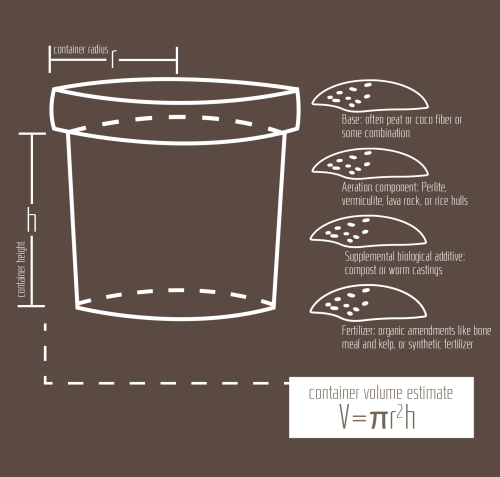Indoor Soil Gardening 101

A 7 Step Guide to Successful Indoor Organic Gardening
Choose a Potting Mix
- Potting Mixes are typically peat-based mixes with perlite and other materials that unlike soil, are light weight and have great air/water holding properties
- Sphagnum Peat Moss is naturally acidic and often used with dolomite lime to raise pH
- Perlite is a coarse substrate derived from volcanic rock and used to improve drainage/aeration
- Coco is made from the husks of a coconut, is pH stable, and provides moisture retention/aeration
- Worm Castings and Composted Waste add beneficial biology that help plants access nutrients in the soil
The Right Environment
- Key components include relative humidity, temperature, CO2, and air circulation/exchange
- Ideal humidity is between 40%-60%
- Some plants like higher humidity, but that can lead to problems with fungus and disease
- Ideal temperature is between 68-75F
- Plants need CO2 to grow - with good air circulation and exchange, a room will naturally have between 300-400 PPM without supplemental CO2
Start With Good Water
- Water quality is essential to plant growth
- PPM (parts per million) or EC (electrical conductivity) measures salts in a solution
- Start off with a low PPM or EC and add nutrients specific to your plant variety requirements
- A Reverse Osmosis system can reduce PPM/EC
- pH should range 5.8-6.2 in hydro and 6.0-6.8 in soil4
- Nutrient "lockout" occurs in too high or low pH levels
Nutrients/ Fertilizers
- Liquid/Dry nutrients can be organic or synthetic
- Over or under fertilizing can cause burning, curling, or yellowing of plants
- Most nutrient bottles are labeled with N-P-K (Nitrogen, Phosphorous, and Potassium)
- When used together, nutrients and supplements will help you achieve maximum results
Grow Lighting
- MH (Metal Halide) and HPS (High Pressure Sodium) are types of HID lights used in grow rooms
- MH lamps = Blue spectrum for vegetative
- HPS lamps = Orange/Red spectrum for flowering
- T5 lamps are high-output fluorescents with low heat/energy consumption ideal for cuttings, mother plants, and short growth cycles
- DE (Double Ended) lighting is a full spectrum HID lamp with a higher par reading than single ended
- Plants in vegetative stage need 15-18 hrs. of light
- Plants in bloom stage need 10-12 hrs. of light
Testing Equipment
- There are many meters available for testing solution pH, PPM, and EC
- Environmental controllers and meters are available to automate and more accurately control and maintain the temperature, humidity, CO2 and lights
- Testing equipment for the water-nutrient solution, light, room temperature and humidity, CO2, and air circulation is the key to providing optimal conditions for a bountiful garden
Optional Accessories
- Grow/Garden room accessories are essential for optimized growth and harvest
- Atmosphere drive devices such as fans, blowers, CO2 emitters, and integrated timers are a grow rooms greatest accessory
- Trellising, stakes, supports, shears, and labels are useful when growing fruiting/flowering crops
- Pest and disease control may be needed and there are many organic options available
